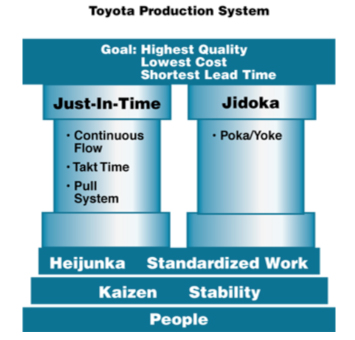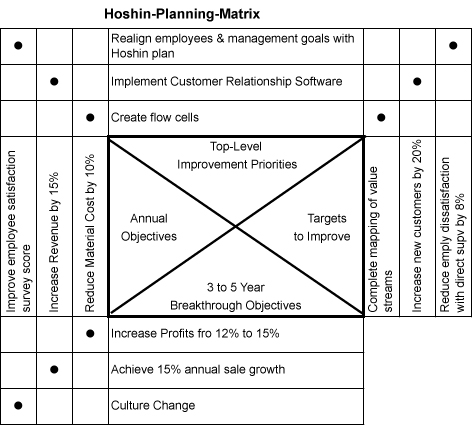Hoshin Kanhri, Strategy Deployment, Policy Deployment, Seven Steps, X-Matrices that turn on their axis, catchball… the list goes on. I don’t know about you, but it all gets a bit overwhelming. Human beings can take any idea and turn it into complicated gobbley-goo. From what I’ve been able to understand, many organizations (including Toyota) use what has been called a “Hoshin” (as well as other names) process to set and deploy a few critical high-level objectives throughout the organization.
Probably all of us have been a part of at least one organization in our career that either had a big list (30 key objectives) of important things to work on or a constantly changing list of important priorities. These lists are always well intentioned and hard to argue with. But in my career, I was always more interested in what it would take to create and sustain competitive advantage than just doing good things. What I observed was that a lack of strategy elegantly deployed was still lack of strategy and usually produced no real sustaining results. In for-profit organizations, regardless of how big the list of objectives was, I observed that “strategy” usually boiled down to Grow and Make More Money (which isn’t really a strategy at all, it’s a hoped-for outcome).
The key to business results is how the Hoshin process compliments, reinforces, and aligns the strategic thinking process designed to create sustainable competitive advantage in a constantly changing world.
But let’s talk about growth and money for a moment. With growth comes increased opportunity. For people, this means greater opportunities for promotion, a chance to learn new things through new assignments, and new intellectual challenges. With increased profitability comes new opportunities for investment and a greater return for shareholders and hopefully employees. It’s hard to argue with the objectives of Growth and Increased Profits, but let’s consider: does this alone drive good strategic behaviors in the organization?
 When I first saw this Toyota House drawing back in the early 1990s, the Objectives that the house was designed to support and achieve were “Highest Quality, Lowest Cost and Shortest Lead-Time.” These were big stretch objectives that helped drive improvement methods and activities throughout the organization. But to me, more importantly, achieving these objectives would provide competitive advantage in the automotive industry of the late 80s and 90s. These objectives were important to people who bought cars, so achieving these objectives would bring more customers to the brand and perhaps create brand loyalty that could provide sustaining competitive advantage. Objectives tied to creating competitive advantage within an industry are the essence of strategy.
When I first saw this Toyota House drawing back in the early 1990s, the Objectives that the house was designed to support and achieve were “Highest Quality, Lowest Cost and Shortest Lead-Time.” These were big stretch objectives that helped drive improvement methods and activities throughout the organization. But to me, more importantly, achieving these objectives would provide competitive advantage in the automotive industry of the late 80s and 90s. These objectives were important to people who bought cars, so achieving these objectives would bring more customers to the brand and perhaps create brand loyalty that could provide sustaining competitive advantage. Objectives tied to creating competitive advantage within an industry are the essence of strategy.
Too often today I see Hoshin in its many names presented as another elegant tool. One of my hobbies is woodworking so believe me I love tools! But without a deep understanding of how to use the tool they can often be expensive, nice things you display on your wall. Recently, I looked at the website of a big consulting company that claims to have considerable expertise helping organizations do Hoshin Planning. They provided an example of a “Hoshin Planning Matrix” that looked something like this:

My question is what does any of this have to do with identifying strategic aims and aligning the organization to the strategy? How does this solve customer problems and bring them to you versus the competition? It looks to me like yet another example of a new form for the same old way of thinking. A list of good things to do.
So, how do you think and act strategically?
It’s important for leaders to clearly express what they want the organization to accomplish (the Objectives). It’s equally important to clearly express why accomplishing those objectives is important. That is the connection of objectives to strategy as in “if we reduce lead-time from 2 weeks to 48 hours (the objective) we will be able to take market share and grow sales 15% (the competitive, strategic implications of lead-time reduction).” Without explaining the competitive advantage we expect to accomplish as a result of our objectives, it can sound like just another good thing to do. Finally, leaders need to leave the “how” to accomplish the objectives to the organization.
The fact is, the Hoshin process can be a powerful tool for helping an organization narrow their focus on a few key objectives that have significant competitive and therefore strategic implications. The discussion about how to accomplish the objectives and the establishment of measures and milestones is what engages and aligns the organization. The discipline to follow the plan in a true PDCA fashion insures progress and learning. But, like other tools, there is no magic in the form. The key to business results is how the Hoshin process compliments, reinforces, and aligns the strategic thinking process designed to create sustainable competitive advantage in a constantly changing world.
Deploying effective strategy needs to be the focus of our Hoshin planning, not filling out forms with abstract, broad, non-differentiating goals. How is Hoshin working for your organization? How are other lean tools working or not working for your organization and why do you think this is?
Managing a Lean Enterprise
Learn how to drive performance and inspire innovation using hoshin kanri, daily management, and A3 process.






